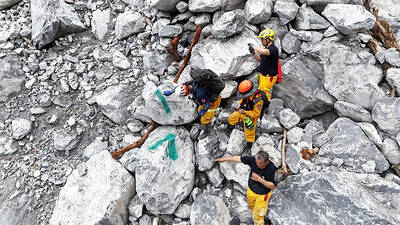A longer-range version of Taiwan’s indigenous Tien Chien II (Sky Sword) missile has been tested and would soon enter production, as part of the country’s efforts to counter China, a military source said.
The goal is to equip the air force’s Indigenous Defense Fighter jets with the extended-range missiles, which would serve as a more powerful deterrent to China’s frequent incursions into Taiwan’s airspace, the source said on Tuesday, speaking on condition of anonymity.
The latest version of the Tien Chien air-to-air missile has a range of 80km compared with the 60km range of the current version, the source said.
The Chungshan Institute of Science and Technology, which is developing the new version of the missile, confirmed that the required combat tests and evaluations have been completed.
Mass production of the upgraded Tien Chien II missile would proceed in accordance with the military’s plans, the institute said, without elaborating.
While neither the institute nor the military source were willing to disclose when production of the new missile would likely begin, local media reports have speculated that it could be as soon as next year.
The air force has ordered 250 to 300 of the upgraded Tien Chien II missiles, at a cost of NT$30 million (US$1.08 million) each, and they would be mounted on the nation’s 129 Indigenous Defense Fighters, the reports said.
As part of the upgrade project, Indigenous Defense Fighters have been retrofitted to carry four instead of two Tien Chien II missiles, which would significantly increase their firepower, the reports said.

Former president Ma Ying-jeou’s (馬英九) mention of Taiwan’s official name during a meeting with Chinese President Xi Jinping (習近平) on Wednesday was likely a deliberate political play, academics said. “As I see it, it was intentional,” National Chengchi University Graduate Institute of East Asian Studies professor Wang Hsin-hsien (王信賢) said of Ma’s initial use of the “Republic of China” (ROC) to refer to the wider concept of “the Chinese nation.” Ma quickly corrected himself, and his office later described his use of the two similar-sounding yet politically distinct terms as “purely a gaffe.” Given Ma was reading from a script, the supposed slipup

Former Czech Republic-based Taiwanese researcher Cheng Yu-chin (鄭宇欽) has been sentenced to seven years in prison on espionage-related charges, China’s Ministry of State Security announced yesterday. China said Cheng was a spy for Taiwan who “masqueraded as a professor” and that he was previously an assistant to former Cabinet secretary-general Cho Jung-tai (卓榮泰). President-elect William Lai (賴清德) on Wednesday last week announced Cho would be his premier when Lai is inaugurated next month. Today is China’s “National Security Education Day.” The Chinese ministry yesterday released a video online showing arrests over the past 10 years of people alleged to be

THE HAWAII FACTOR: While a 1965 opinion said an attack on Hawaii would not trigger Article 5, the text of the treaty suggests the state is covered, the report says NATO could be drawn into a conflict in the Taiwan Strait if Chinese forces attacked the US mainland or Hawaii, a NATO Defense College report published on Monday says. The report, written by James Lee, an assistant research fellow at Academia Sinica’s Institute of European and American Studies, states that under certain conditions a Taiwan contingency could trigger Article 5 of NATO, under which an attack against any member of the alliance is considered an attack against all members, necessitating a response. Article 6 of the North Atlantic Treaty specifies that an armed attack in the territory of any member in Europe,

The bodies of two individuals were recovered and three additional bodies were discovered on the Shakadang Trail (砂卡礑) in Taroko National Park, eight days after the devastating earthquake in Hualien County, search-and-rescue personnel said. The rescuers reported that they retrieved the bodies of a man and a girl, suspected to be the father and daughter from the Yu (游) family, 500m from the entrance of the trail on Wednesday. The rescue team added that despite the discovery of the two bodies on Friday last week, they had been unable to retrieve them until Wednesday due to the heavy equipment needed to lift